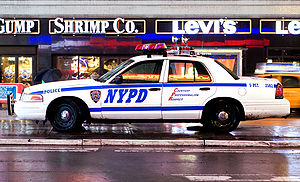- Color of the day (police)
-
The color of the day is a signal used by undercover officers of some police departments in the USA.[1] It is used to assist in the identification of plainclothes police officers by uniformed officers. Perhaps its best known use is by the New York City Police Department (NYPD), the NYPD Transit Bureau (formerly the New York City Transit Police) and the NYPD Housing Bureau (formerly the New York City Housing Authority Police Department) among other law enforcement agencies.[2][3] An undercover police officer will wear a headband, wristband or other piece of clothing in the same color as the "color of the day";[3] this color is told to officers at the station house before they start work.[1] The system is for officer safety and first started during the violence of the 1970s and 1980s New York City.[3] The color of the day system is not known by most of the public but it is found in the media, such as newspapers, in fiction, and television, such as episodes of NYPD Blue and recently Law and Order: SVU.
Contents
Purpose
New York City is a very large metropolitan city with a population of over 8,310,000[4] people with over 18,800,000 people[5] living in the area around it. An extra 500,000 people enter the city during a weekday.[6] Many different police agencies operate in the New York area. The color of the day system is about officer safety. With so many armed officers in the city, undercover police officers need to have an easy to use system in place to provide for discreet, but easy identification of plainclothes officers by uniformed ones. The system is in place to prevent uniformed officers from interrupting undercover operations.
History
The NYPD Street Crimes Unit started in 1971. From the late 1970s through the early 1990s, crime in New York City was at record levels.[7] Undercover officers were asked to go into areas such as subways in plain-clothes or dressed as a homeless person as a decoy. Many of these officers were black and had a fear that uniformed officers would mistake them for criminals in a use-of-force situation.[8] Many of these officers would dress and pretend to be drunk, homeless people or as decoy victims in order to catch muggers who were attacking those at-risk groups. The color of the day system was developed to prevent friendly fire incidents. In the beginning, specifically colored headbands were given to each undercover Street Crime Unit member. Other officers would be briefed on that color to allow them to quickly recognize the undercover officers, while the general public would not notice anything unusual. This began the "Color of the Day" system. Later they also used wristbands in a similar manner. Today's officers often dress in the color.
Knowledge by others
The color of the day recognition system is written about by authors, but it is not often known about by most people in New York City. Books that talk about it are Roger Abell's The Black Shields[8], Greg Faliis' Just the Facts Ma'am,[1] and Leslie Glass' novel, A Killing Gift.[9]
See also
References
- ^ a b c Fallis, Greg (1999). Just the Facts Ma'am: A Writer's Guide to Investigators and Investigation Techniques. Writer's Digest Books. p. 139. ISBN 089879823X.
- ^ James, George (24 August 1994). "Police Agencies Share Rules for Recognition". New York Times. http://query.nytimes.com/gst/fullpage.html?res=9C0DE2DB1239F937A1575BC0A962958260. Retrieved 2008-09-17.
- ^ a b c Krauss, Clifford (24 August 1994). "Subway Chaos: Officer Firing at Officer". New York Times. http://query.nytimes.com/gst/fullpage.html?res=9C04E7DC1239F937A1575BC0A962958260&sec=&spon=&pagewanted=2. Retrieved 05-10-2008.
- ^ "The "Current" Population of New York City (2007)". New York City Department of City Planning. http://www.nyc.gov/html/dcp/html/census/popcur.shtml. Retrieved 09-03-2009.
- ^ "Annual Estimates of the Population of Metropolitan Statistical Areas: April 1, 2000 to July 1, 2007". U.S. Census Bureau. http://www.census.gov/popest/metro/files/2007/CBSA-EST2007-alldata.csv. Retrieved 09-03-2009.
- ^ "Census Bureau Releases First-Ever Data On Daytime Populations for Cities and Counties". U.S. Census Bureau. http://www.census.gov/Press-Release/www/releases/archives/population/005822.html. Retrieved 09-03-2009.[dead link]
- ^ "New York Crime Rates 1960 - 2007". The Disaster Centre. http://www.disastercenter.com/crime/nycrime.htm. Retrieved 08-03-2009.
- ^ a b Abel, Roger L. (2006). The Black Shields. AuthorHouse. p. 535. ISBN 1420844601.
- ^ Glass, Leslie (2003). A Killing Gift. New York: Onyx Books. p. 130. ISBN 0451410912.
- NYPD'S (New York Police Department) Street Crime Unit by J J Breslin, published in Police Product News 1979
- Changes, Real and Imagined in the NYPD by Jim Fay ENN NYC-NJ Metro Correspondent
External links
Categories:- Law enforcement in the United States
- Law enforcement in New York City
- Law enforcement techniques
Wikimedia Foundation. 2010.

